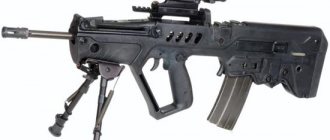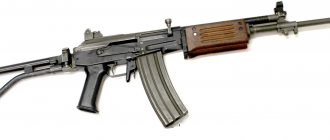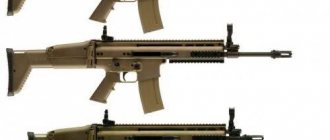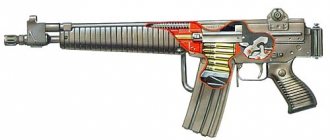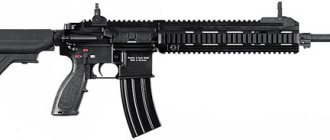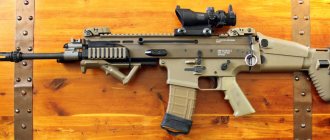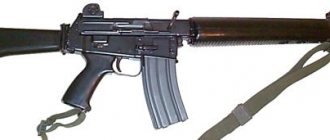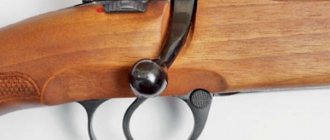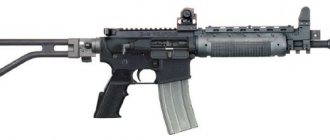Assault rifle Tavor TAR-21 The automatic assault rifle "Tavor" TAR-21 is the main weapon of the modern Israel Defense Forces. In various versions, it is also used as a weapon by various special forces units of both Israel and a number of other countries. There are also civilian versions of this weapon. In 2014, the US National Rifle Association awarded the Israeli development Micro-TAR-21 X95 the title of “Weapon of the Year”.
According to the Israeli tradition of giving weapon models names associated with historical places, usually known from the biblical Old Testament, the name of the machine gun comes from Mount Tabor located in the north of the country (in Russian it was usually called “Favor”). The abbreviated designation TAR-21 is based on the English name Tavor Assault Rifle-21 - the Tavor assault rifle of the 21st century.
Historical reference
In 1993, the command of the Israel Defense Forces (IDF) decided to replace the outdated Galil assault rifle (often called the “Jewish Kalashnikov” for its great similarity in design) with the American M16 rifle. However, shortly before this, the state company Israel Military Industries (IMI) proactively began work on its own new small arms chambered for the NATO 5.56x45 mm cartridge.
Development
Unlike previous models of small arms from the Israeli company, the new machine gun was not a remake or modernization of other weapons. It is noteworthy that the concept of the future Tavor was put forward by civilian designers who had no previous experience in weapons design work. Nevertheless, their ideas were almost completely preserved in the final appearance of the rifle.
The project was considered promising, and work on it continued, despite the purchase of American weapons. IMI initially began to develop not just a single type of weapon, but a whole complex of individual small arms based on the same mechanics and the most standardized parts.
First prototypes
The first prototypes under the IMI development were presented to the public in 1995 under the designation "M-203". But in order to avoid confusion with the under-barrel grenade launcher of the same name, the weapon was soon renamed AAR (Advanced Assault Rifle - a promising assault rifle), and ultimately the rifle received its final name Tavor TAR-21, under which its production began in 1998.
Army tests of the first TAR-21 prototypes took place in the late 1990s and early 2000s. At first, certain shortcomings of the machine gun were identified: unreliability, difficulties when changing the magazine in a prone position, imperfect sight, too thick pistol grip.
As part of further testing, an exercise was conducted in one of the IDF infantry schools, during which two platoons, one of which was armed with Tavors and the other with an M16, stormed a building with a mock enemy under the same conditions and fought an urban battle. According to the results of the exercises, the TAR was recognized as a more accurate and easy-to-use weapon, in particular, it showed higher shooting accuracy in a stationary position and in motion.
In 2004, a modified version of the TAR-21 entered service with some parts of the Israeli security forces. But work to finally eliminate the identified shortcomings of the assault rifle lasted until 2007. By that time, IMI had already become a private joint stock company and was renamed IWI (Israeli Wearons Industries Ltd).
Version Micro-TAR-21 X95
Production for 2022
The Tavor TAR-21 assault rifle has been in service with the IDF since 2007. In the very first years, army units were fully armed with Tavors in various versions; the rearmament of reserve and auxiliary units has been carried out as planned until the present day.
In the 2010s, the manufacturer released a wide range of modifications of the TAR-21, the main of which are:
- GTAR-21 (Grenade-TAR) - basic model with a unit for mounting an M203 under-barrel grenade launcher;
- STAR-21 (Commando-TAR) - lightweight and shortened version;
- MTAR-21 (Micro-TAR) is the most compact machine gun. To reduce its dimensions, the large trigger guard covering the entire pistol grip was replaced with a small traditional one;
- STAR-21 (Sniper-TAR) is a sniper version of the rifle. Equipped with an optical sight and bipod, otherwise similar to the basic machine gun;
- TC-21 (Tavor Carabine) - civilian version of TAR. It does not have the ability to fire in bursts, is equipped with a magazine for 10 rounds and is equipped with a kind of “cushion” under the cheek on the upper side of the receiver.
Compact versions of the TAR-21 for the Israeli army were primarily produced as personal self-defense weapons for armored vehicle crews, gun crews, etc. The KTAR version has been completely phased out since 2022. According to the manufacturer, its current plans include focusing on the production and sale of the Tavor MTAR-21 X95 and Tavor 7 (versions for 7.62 mm caliber).
Sniper version of STAR-21 with night sight
1st layout
The first conceptual layout of the Tavor tar 21 was created not by professional designers, but by 2 civilian designers from Formtech, who had no experience working with the gun at all. Still, most of the design details made it into the final product. To reduce the cost of the gun, we had to give up:
- complex support bipods;
- an expensive butt with a rather complex configuration.
"Tavor", like other modern standards, was developed using CAD software.
Overall management of the final project was provided by Moti Rosen, a reserve colonel and deputy general director of IMI. Engineers Amnon Shiloni, Boron Erez and Zalman Shevs also took part in the work.
custom_block(1, 48577180, 1350);
Design Features
The TAR 21 assault rifle is equipped with Picatinny rails on top and sides, on which you can install optical and collimator sights, tactical flashlights and laser target designators (LTS). The standard diopter sight of late models retracts directly into the Picatinny rail.
Initially, the Tavor was equipped with an expensive ITL MARS sight combined with a laser target. In order not to tire the soldier by constantly turning it on and off, the sight turns on automatically when the bolt is pulled and turns off when the weapon is unloaded. The laser pointer button is built into the rifle's forend. Late-release TAR-21 models are equipped with a cheaper Merrolight sight without a laser pointer.
In addition, the Israeli machine can also be equipped with an ITL Mini N/SEAS night vision device, an M203 under-barrel grenade launcher and a folding bipod. A muffler can be installed on the barrel.
Bullpup circuit
The Tavor assault rifle is made according to the bullpup design. This term refers to a “linear” pattern in which the butt is on the same axis with the barrel. This solution allows the weapon's center of gravity to be shifted closer to the shooter's shoulder, which provides the weapon with increased shooting accuracy. However, there is also a noticeable drawback: the sights need to be placed slightly higher than the barrel.
The ergonomics of the TAR-21 ensure not only the convenience of the shooter, but also his secrecy
Automation
The basis of automation is the removal of powder gases from the barrel through a gas outlet unit located above the barrel and hidden by the body of the weapon. The barrel is locked by turning the bolt by 7 lugs - which is similar to the design of the American M16. The machine gun also has a slide stop; the button that controls it is located at the bottom of the body behind the magazine.
On both sides of the receiver there are windows for ejecting spent cartridges, since there are bolt options (with ejectors and reflectors attached to them) with ejection of spent cartridges on both the right and left (option for left-handed people) sides. In this case, the unused window is closed with a blank.
The trigger is a trigger type, located in the butt. A three-position safety switch for firing modes is located above the pistol grip. In a standard rifle it is placed on the left side, but the possibility of installing it on the right is also provided.
Gas piston
The gas piston, rigidly fixed to the bolt frame, has a long stroke. The return spring, partially hidden inside the hollow gas piston rod, ensures the movement of the bolt frame, “hung” inside the body on one guide rod. The TAR-21 gas vent mechanism of later releases is adjustable, with 4 positions.
Frame
The load-bearing body part, which is the stock of the weapon, is made of high-strength composite materials and light alloys based on aluminum. In some places the body is reinforced with steel inserts. This achieves one of the advantages of the TAR-21 rifle - its relatively light weight. The receiver is waterproof, minimal gaps and holes prevent sand and dirt from entering the mechanism, which increases the reliability of the weapon.
Cutouts for the charging handle are made on both sides; normally the handle is located on the left. The charging handle itself is not rigidly connected to the bolt frame and remains motionless when firing.
Barrel and handle
The TAR-21 barrel has six right-hand rifling, their pitch is 1:7. In modifications of the rifle with a long barrel, this step is 1:10, with a short barrel - 1:10. On the right side there is a lock with which you can replace the barrel of the machine gun.
The barrel is rigidly connected to the top Picatinny rail, on which the sight is mounted. The trigger guard is made in one piece along the entire length of the pistol grip with the body, as is the handle itself. The force on the trigger, depending on the modification, ranges from 2.5 to 4 kg. Above the pistol grip in the machine gun body there are 4 large holes on each side for air cooling of the barrel.
Tavor MTAR-21 X95 with additional front handle, silencer and sighting optics
Accessories
Because the Tavor was initially created to replace the M16 family, it has a wide range of modifications, as well as accessories for performing various tactical tasks:
- trunks of different lengths;
- optical/night sights;
- adapter for installing an M203 underbarrel grenade launcher;
- muffler.
If necessary, the rifle makes it possible to fire NATO standard rifle grenades, which are mounted on the barrel.
The Tavor is equipped with an ITL MARS collimator sight; it has an integrated laser designator and infrared sight, which makes the overview of the combat situation more intuitive. At the same time, the Tavor does not have its own “metal” sight - this is a significant drawback. Small consolation will be the fact that if the ITL MARS fails (batteries empty or broken), you can use the open iron sight, which is located on the MARS body. Some types of rifles are equipped with ITL N/SEAS, an additional night vision sight.
Specifications
Cartridges and caliber
The basic version of Tavor TAR-21 has a caliber of 5.56 mm, designed to use 5.56x45 mm NATO (M193/SS109) cartridges. Some modifications (MTAR-21 X95R and the Ukrainian version of this rifle “Fort”) are designed for 5.45x39 mm cartridges.
In addition, the Tavor was optionally produced in calibers 9x19 mm Luger/Parabellum and .300 AAC Blackout (7.62x35 mm). Since 2022, the manufacturer has been actively promoting the Tavor 7 modification for export - a variant of the 7.62 mm NATO caliber rifle (7.62×51 mm, .308 Winchester).
Dimensions, weight, length
| Options | Values for main modifications | ||
| TAR-21 | STAR-21 | MTAR-21 | |
| Weapon length | 720 mm | 640 mm | 590 mm |
| Barrel length | 460mm | 380 mm | 330 mm |
| Weight without magazine | 3.27 kg | 3.18 kg | 2.95 kg |
Store capacity
The TAR-21 uses standard M16 box magazines with a capacity of 20 or 30 rounds. This ensures the unification of equipment for different types of small arms in the Israel Defense Forces. Optionally, extended magazines are used - from 60 rounds to 100 rounds (STANAG), as well as magazines with 20/25/32 rounds for the 9-mm version of MTAR-21.
Firing range and lethal force
The target range of the TAR-21 is 500 meters; in the sniper version of the rifle (STAR-21) it is set to 550 meters. The effective firing range is:
- On the head target - up to 100 meters;
- On the chest target - up to 150 meters;
- On a full-height target - up to 300 meters.
Fire modes and muzzle velocity
The Tavor TAR-21 assault rifle allows you to fire in two modes: single shots and continuous bursts. The combat rate of fire of this weapon is 750-900 rounds per minute. In the TAR-21 X95S modification, this figure is increased to 1200 rounds per minute.
The initial bullet speed in the basic version of the TAR-21 is 910 m/s, in more compact modifications of the rifle - 870-890 m/s.
TAR-21 is characterized by increased impact resistance
Current status
The IDF never took responsibility for purchasing the Tavor, but the entire development process was carried out very closely by the IMI and the IDF. Namely, the IDF has developed a list of technical requirements for the new product. Initially, it was planned to complete the development within 3 years; in 1995, the layout was ready. In 1996, experienced standards were tested in various infantry units.
In 1999, the main problem with Tavor was the quality of production of serial samples. There were frequent failures, but then all the “childhood diseases” were eliminated.
custom_block(5, 7973207, 1350);
In 2003, there were rumors that with the reduction of the military budget, the purchase of Tavor rifles would be frozen. They wanted to reduce military purchases by more than 1.1 billion dollars. But Tavor secured a contract for the sale of Israeli-made Tavor rifles to the Indian army. The agreement was valued at hundreds of millions of dollars.
Combat use
Since 2000, various versions of the TAR in limited quantities have entered service with various units of the Israeli army, primarily special forces. For the Israeli military, the initial deterrent to adoption was the price: a basic TAR costs more than a thousand dollars. American M16s were previously supplied to Israel on preferential terms at a cost: many times less.
In 2002, the TAR-21 entered service with several companies of the Givati brigade, which actively participated in the special operation Protective Wall. Since 2010, the standard TAR-21 in service with the Givati and Golani brigades has replaced the shortened MTAR-21 assault rifle. In general, TAR-21 rifles have been constantly and actively used by the Israeli military during all operations in the territories of Palestine and South Lebanon conducted since the early 2000s.
Batches of Tavors, in addition to Israel, were also purchased for arming individual, usually special units, by many countries, including Vietnam, India, Colombia, Thailand, Turkey, and in less significant quantities - Azerbaijan, Brazil, Guatemala, Honduras, Portugal .
In 2006, Georgia signed a large contract for the purchase of about 7 thousand Israeli TAR-21 assault rifles for special forces and the army as “military assistance”. These weapons were used by the Georgian side during the 2008 armed conflict with South Ossetia.
Plans to rearm the Ukrainian army with Tavors caused a great stir. Ultimately, the conversation turned to the final assembly of such assault rifles under the Fort brand from Israeli components. It was intended to equip these rifles, first of all, with armed formations operating from the Ukrainian side in the conflict around Donbass (in particular, the Azov battalion). However, this project was never realized.
The TAR-21 has been used by the Israeli military in operations in Palestine and South Lebanon since the early 2000s
Modifications of TAR-21
- GTAR-21 is a variant with a mount for a 40mm grenade launcher.
- Tar-OICW is an upgraded version of the TAR-21, which includes the installation of a data transmission strip, a ballistic computer, a laser range finder and electric sighting devices.
- CTAR-21 is a small-sized version with reduced weight and a shortened barrel, for special operations forces.
- MTAR-21 is a smaller version.
- MTAR-21 model X95R. Equipped with a 330 mm barrel. Chambered for 5.45x39 mm.
- MTAR-21 “Zittara” is a modification of Indian production, converted to the Indian 5.56x30 mm cartridge.
- MTAR-21 X95 7.62 is a modification chambered for the 7.62x51mm NATO cartridge, which increases the effective range and has a greater lethal effect.
- STAR-21 - sniper version with optical sight and bipod.
- TC-21 – civilian shortened self-loading version.
Advantages and disadvantages
In various comparative tests, the TAR-21 showed advantages over its counterparts, primarily the American M16A4, in the following indicators:
- Relatively light weight of the weapon;
- Increased impact resistance during use;
- High functional reliability when used in extreme conditions;
- Full anti-corrosion coating;
- Possibility of continuous round-the-clock use without preliminary setup;
- Ergonomics, ensuring not only the convenience of the shooter, but also his secrecy;
- Bilaterality (possibility of right- and left-sided use).
It is also noted that the center of gravity shifted to the rear is located close to the shooter’s body and provides him with reliable holding and aiming along the front while moving.
Among the disadvantages of the Israeli assault rifle Tavor TAR-21 are:
- Limited functionality when selecting firing modes;
- Short sighting range;
- High price.
In general, “Tavors” are characterized extremely positively, especially distinguished by high maneuverability and ease of shooting offhand. Their modern and precise aiming system, which is attached directly to the barrel, is also highly appreciated.
